There’s no shame in picking up a workout routine with a particular aesthetic goal in mind. But it shouldn’t be your only motivation for exercising—and that couldn’t be more true when you’re training your midsection muscles to reap the benefits of a strong core.
“The core is, I would say, probably one of the most—if not the most—important part of your body,” says certified personal trainer Kelly Froelich, CPT. “…It’s foundational to being a human being and [accomplishing] everyday movement.”
Here, details on the benefits of a strong core, plus the exercises you can practice to score those perks.
In This Article
Experts In This Article
First, which muscles make up your core?
Most people typically think of their core as just the abdominal muscles seen in the mirror, says Nancy Chen, CPT, certified personal trainer, 500-hour registered yoga teacher, and Rumble Boxing trainer. But in reality, “the core is much more comprehensive,” she adds.
Specifically, the core consists of the rectus abdominis (the so-called “six-pack” muscles); the internal and external obliques on the sides of your trunk; the transverse abdominis (a deep muscle that wraps around your abdomen like a corset); the erector spinae, lumbar multifidus, and quadratus lumborum on your back; and even the diaphragm, pelvic floor, and iliac psoas at the bottom of your trunk, according to a 2020 review in the International Journal of Environmental Research and Public Health.
“It’s truly the core of your body, the core of so many different movements we do, whether we’re going through everyday movements or we’re lifting, dancing, biking, swimming, or running,” Chen says.
The benefits of a strong core
1. It moves and protects the spine
The core’s main job is to move and stabilize your spine, according to the American Council on Exercise.
To bend into a forward fold—whether you’re practicing yoga or picking a shoe off the floor—you call on your rectus abdominis. To stand up straight from this position, your erector spinae (which lie on the sides of your spine) activate. And when you’re quickly changing directions during your rec softball game or squatting a loaded barbell, these muscles stabilize and protect the spine to reduce the risk of injury.
Having strength in the muscle group ensures your core can provide that much-needed protection, especially over prolonged periods.
2. It may reduce low back pain and injury risk
While the causes of chronic low back pain are complex, a weakening of stabilizing core muscles can contribute to discomfort. Changes in lumbar multifidus and transversus abdominis activity are typically observed in folks with low back pain, according to a 2015 review in the Journal of Physical Therapy Science.
However, core strength training may help alleviate symptoms, per the journal. A small 2015 study in the Journal of Back and Musculoskeletal Rehabilitation found that performing core strengthening exercises—in addition to lumbar flexibility and glute max strengthening moves—can be an effective rehabilitation technique for people with chronic low back pain.
A strong core also ensures you work out with correct form and, in turn, less discomfort, Froelich says. Consider a deadlift: Without necessary core strength and bracing, you might round your lower back while lifting and lowering the barbell, which can lead to pain and, in some cases, injury. There’s also a risk of falling forward with the weight of the equipment, she notes.
Similarly, “any time that you’re pressing stuff overhead, I’m thinking of that engagement of the core to help support your spine,” Chen adds. “[When] the trunk of your body is really strong, if you’re doing a deadlift or a shoulder press, it can help avoid any back injuries.”
3. It enhances balance
A strong core goes hand-in-hand with solid balance. Core stability training is linked with improved balance and stability, per a small 2018 study in Acta of Bioengineering and Biomechanics, which can have notable effects on your everyday life and workout routine.
If you were to accidentally walk on a patch of ice, for instance, bracing your strong core muscles can help you stay upright and avoid a nasty fall, Froelich says.
“In yoga, the core is [not only] so important for helping you move through the movement, but also in a lot of our balancing poses, it helps keep you stable throughout all those flows,” Chen says.
4. It boosts performance
Working in tandem, your core muscles transfer force between the lower and upper extremities during day-to-day movements (think: picking a box off the floor and putting it onto the top shelf of your closet), your workout routine, and sports, according to a 2013 review in Sports Health.
In turn, building a strong core may take your performance to the next level. A 2023 review in Biology of Sport found that core training improved throwing and hitting velocity and distance, as well as vertical and horizontal jump performance.
Similarly, a separate 2023 review in Behavioral Science showed that core training had a large effect on general athletic performance, specifically elements like core endurance and balance of athletes. (That said, it had little effect on sport-specific performance, according to the review.)
5. It supports healthy posture
Many of the back and deep trunk muscles that make up your core play a role in maintaining posture, so don’t overlook them in your workout routine, Froelich says.
The multifidus, quadratus lumborum, and erector spinae—plus the transverse abdominis, diaphragm, and pelvic floor—are linked with joint stabilization and are responsible for providing stability throughout various spinal segments, helping to maintain good posture, according to a 2018 paper in Scoliosis and Spinal Disorders.
“The core is, I would say, probably one of the most—if not the most—important part of your body … It’s foundational to being a human being and [accomplishing] everyday movement.” —Kelly Froelich, CPT
Signs you may have a weak core
If your core strength isn’t up to par, you may be more prone to injury and experiencing back pain, according to the experts. Likewise, your technique while lifting may be compromised, compounding any pain you might be experiencing, or you may struggle with holding your balance during everyday activities or workouts.
The best way to tell if you should prioritize core exercises: Perform a basic plank or hollow-body hold, Chen suggests. “It’s really easy to do a core exercise but not work your core,” she explains. “With a lot of them, it’s easy to like to use momentum or use other parts of your body to [do] the actual movement. But if you don’t feel the core initiating or driving that movement, it doesn’t mean you’re necessarily doing it properly.” A static plank and hollow-body hold, however, forces you to fully activate all of your core muscles—when performed properly.
If you need to use a modification for either of these movements (think: performing the plank with your hands on an elevated surface, bending your knees in the hollow-body hold), that may be a sign to focus on your core, Chen says. Ideally, you’ll be able to hold these isometric exercises for at least 30 seconds, Froelich adds.
These exercises specifically test muscular endurance—the ability of your muscles to produce and maintain force over extended periods—but it’s still beneficial in understanding core strength (the ability to create maximal muscle force). Core endurance allows for prolonged stabilization throughout the muscle group. When the core is fatigued, it may not be able to produce as much force, according to information published in a 2019 article in Frontiers in Physiology.
The best exercises for a strong core
Core exercises don’t need to be complicated, Chen says. The best moves are often the basics, including planks, dead bugs, and sit-ups, that can be progressed by adding weight, increasing time under tension, or playing with tempo.
To reap the benefits of a strong core, start building your foundation with the below exercises, demonstrated by Chen. Kick off your core workout with the isometric forearm plank and hollow-body hold, then move on to the explosive, dynamic movements, she advises.
1. Forearm plank
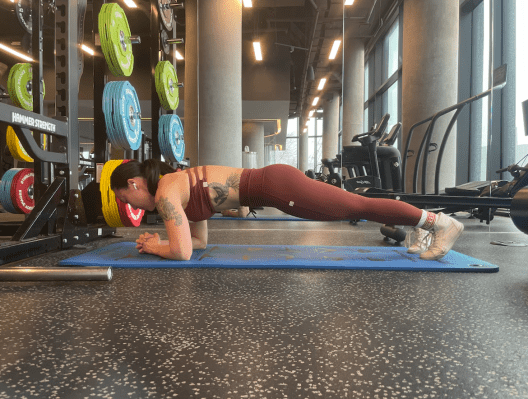
- Start in a tabletop position on the floor with your shoulders stacked with your wrists, your hips stacked with your knees, and the tips of your toes resting on the ground. Engage your core by bracing as if someone is about to punch you in the gut.
- Lower your elbows down to the floor one at a time so your forearms rest on the ground. Your elbows should be aligned with your shoulders.
- Then, step your feet back one at a time so your legs are fully extended and your feet are hip-width apart. Gaze down at the floor slightly in front of your hands.
- Hold this position, your body forming a straight line from your head to your heels. Continue to breathe.
- Hold for 30 seconds to 1 minute.
2. Hollow-body hold
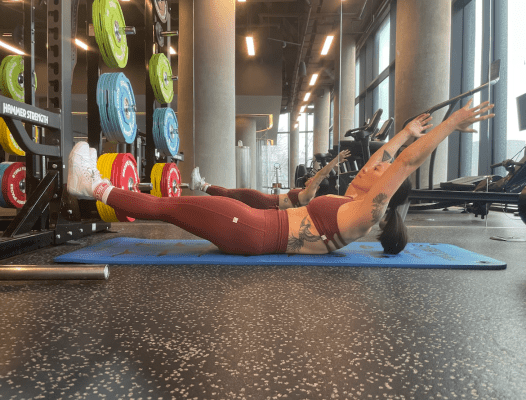
- Lie on your back the floor with your legs fully extended and glued together, your arms extended above your head, and your palms facing toward one another. Gaze up toward the ceiling. Engage your core by bracing as if someone is about to punch you in the gut.
- Keeping your back flat and tailbone pressed against the ground, simultaneously lift your head, neck, upper back, and legs off the floor. Your body should curve like a banana, with your legs hovering a few inches above the ground.
- Hold this position, continuing to breathe.
- Hold for 15 to 30 seconds.
3. Dead bug
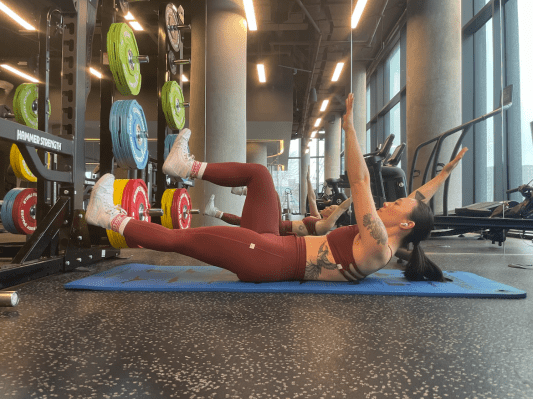
- Start in a reverse tabletop position on the floor, lying on your back with your knees bent at 90 degrees and stacked with your hips and your toes pointed toward the ceiling.
- Extend your arms up toward the ceiling, your wrists stacked with your shoulders and your palms facing away from you.
- Engage your core by bracing as if someone is about to punch you in the gut and lift your head, neck, and upper back off the floor. Gaze toward the ceiling.
- On an inhale, simultaneously lower your right arm to the floor above your head and extend your left leg, lowering it to the floor. Your arm and leg should hover a few inches above the ground.
- On an exhale, reverse the movement, driving your right arm back up in front of your shoulder and your left knee back into the reverse table-top position. That’s one rep.
- Do 15 to 20 reps, alternating sides.
4. Sprinter sit-up
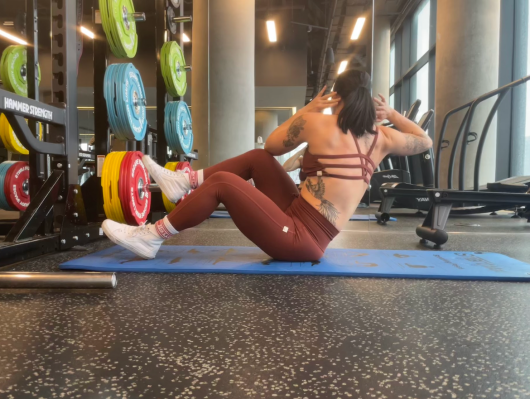
- Lie on the floor with your legs slightly bent and your heels resting on the ground. Your arms are tucked at your sides and your elbows are bent so your hands are in front of your chest. Engage your core by bracing as if someone is about to punch you in the gut. Gaze toward the ceiling.
- On an exhale, quickly lift your torso off the floor and rotate through the spine to the right while simultaneously driving your right knee toward your chest. Allow your gaze to follow through the rotation.
- Tap your left elbow to your right knee. Then on an inhale, reverse the movement, rotating through the spine back to center and lowering your torso and right heel back to the floor. That’s one rep.
- Do 15 to 20 reps, alternating sides.
5. Double crunch
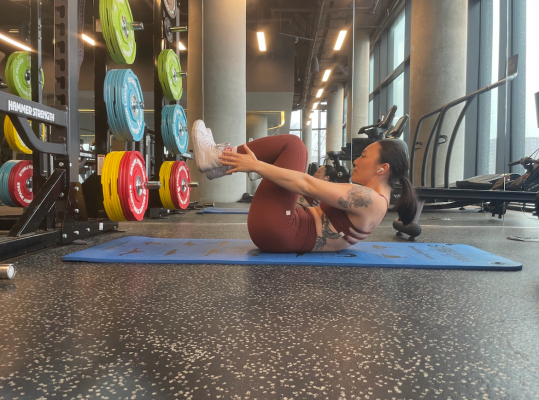
- Start in a reverse tabletop position on the floor, lying on your back with your knees bent at 90 degrees and stacked with your hips and your toes pointed toward the ceiling. Your arms are resting at your sides, your palms facing toward one another.
- Engage your core by bracing as if someone is about to punch you in the gut. Gaze toward the ceiling.
- On an inhale, simultaneously raise your arms above your head, your biceps in line with your ears, and extend your legs, lowering them until they’re hovering a few inches above the ground.
- On an exhale, drive your knees toward your chest, quickly lift your head, neck, and upper back off the floor, and drive your hands toward your feet. That’s one rep.
- Do 15 to 20 reps.
6. Supported kick-out
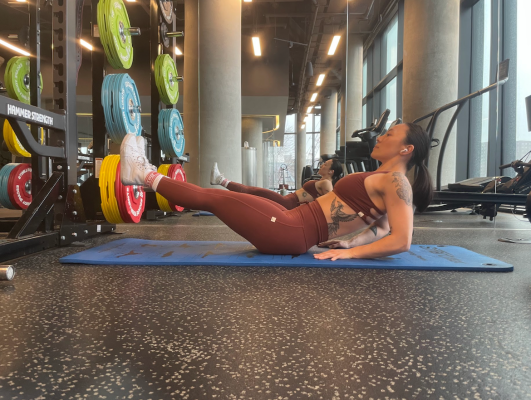
- Sit on the floor with your heels resting on the ground, your knees slightly bent, and your hands resting on the floor behind your back. Glue your legs together. Gaze forward and engage your core by bracing as if someone is about to punch you in the gut.
- Hinge back at the hips slightly, allowing your elbows to bend, then lift both of your feet off the ground as high as is comfortable. This is the starting position.
- On an inhale, simultaneously straighten your legs and lower your torso backward to the floor, gently using your hands for additional support.
- On an exhale, reverse the movement, driving your knees toward your chest and lifting your torso back to the starting position. That’s one rep.
- Do 15 to 20 reps.
7. Oblique twist
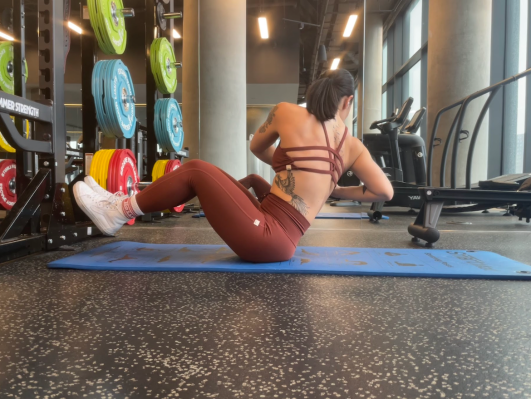
- Sit on the floor with your heels resting on the ground, your knees slightly bent, and your hands interlaced in front of your chest. Glue your legs together. Gaze forward and engage your core by bracing as if someone is about to punch you in the gut.
- Hinge back at the hips slightly, then lift both of your feet off the ground as high as is comfortable. This is the starting position.
- Keeping your back flat and feet lifted, slowly rotate through the spine to the right, allowing your gaze to follow.
- Then, reverse the movement, rotating through the spine back to center. That’s one rep.
- Do 15 to 20 reps, alternating sides.
Well+Good articles reference scientific, reliable, recent, robust studies to back up the information we share. You can trust us along your wellness journey.
- Oliva-Lozano JM, Muyor JM. Core Muscle Activity During Physical Fitness Exercises: A Systematic Review. Int J Environ Res Public Health. 2020 Jun 16;17(12):4306. doi: 10.3390/ijerph17124306. PMID: 32560185; PMCID: PMC7345922.
- Chang WD, Lin HY, Lai PT. Core strength training for patients with chronic low back pain. J Phys Ther Sci. 2015 Mar;27(3):619-22. doi: 10.1589/jpts.27.619. Epub 2015 Mar 31. PMID: 25931693; PMCID: PMC4395677.
- Kumar T, Kumar S, Nezamuddin M, Sharma VP. Efficacy of core muscle strengthening exercise in chronic low back pain patients. J Back Musculoskelet Rehabil. 2015;28(4):699-707. doi: 10.3233/BMR-140572. PMID: 25467999.
- Szafraniec R, Barańska J, Kuczyński M. Acute effects of core stability exercises on balance control. Acta Bioeng Biomech. 2018;20(4):145-151. PMID: 30520448.
- Huxel Bliven KC, Anderson BE. Core stability training for injury prevention. Sports Health. 2013 Nov;5(6):514-22. doi: 10.1177/1941738113481200. PMID: 24427426; PMCID: PMC3806175.
- Rodríguez-Perea Á, Reyes-Ferrada W, Jerez-Mayorga D, Chirosa Ríos L, Van den Tillar R, Chirosa Ríos I, Martínez-García D. Core training and performance: a systematic review with meta-analysis. Biol Sport. 2023 Oct;40(4):975-992. doi: 10.5114/biolsport.2023.123319. Epub 2023 Feb 3. PMID: 37867742; PMCID: PMC10588579.
- Dong K, Yu T, Chun B. Effects of Core Training on Sport-Specific Performance of Athletes: A Meta-Analysis of Randomized Controlled Trials. Behav Sci (Basel). 2023 Feb 9;13(2):148. doi: 10.3390/bs13020148. PMID: 36829378; PMCID: PMC9952339.
- Czaprowski D, Stoliński Ł, Tyrakowski M, Kozinoga M, Kotwicki T. Non-structural misalignments of body posture in the sagittal plane. Scoliosis Spinal Disord. 2018 Mar 5;13:6. doi: 10.1186/s13013-018-0151-5. PMID: 29516039; PMCID: PMC5836359.
- Santos MS, Behm DG, Barbado D, DeSantana JM, Da Silva-Grigoletto ME. Core Endurance Relationships With Athletic and Functional Performance in Inactive People. Front Physiol. 2019 Dec 18;10:1490. doi: 10.3389/fphys.2019.01490. PMID: 31920697; PMCID: PMC6930174.
Source: Well and Good







